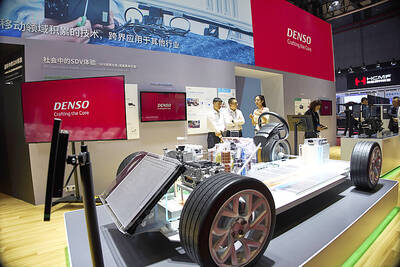Pegatron Corp (和碩), Apple Inc’s second-largest iPhone assembler, yesterday reported a nearly 40 percent annual drop in net income for last quarter, dragged down by weak iPhone sales and declining contributions from its components subsidiaries.
Net profit last quarter was NT$3.72 billion (US$127.4 million), compared with NT$5.86 billion a year ago, marking the company’s lowest record over the corresponding period in the past five years, company data showed.
“The ramp-up of a major communication product started later than planned and the peak season for the product ended earlier than expected. Pegatron’s expanded production only ran on full capacity for one or two months,” chief financial officer Charles Lin (林秋炭) told a teleconference.
A low utilization rate, surging costs on idle personnel and capacity expansion expenses affected Pegatron’s margin performance last quarter, Lin said.
Gross margin fell 1.55 percentage points annually to 3.2 percent during the October-to-December quarter, the lowest since the fourth quarter of 2012. Operating margin shrank 1.3 percentage points to 1.2 percent, the weakest since the third quarter in 2013.
The sluggish earnings performance of component subsidiaries, such as Casetek Holding Ltd (鎧勝) and Kinsus Interconnect Technology Corp (景碩), also weighed on Pegatron’s margins, Lin said.
“The impact from the components subsidiaries accounted for between 30 and 40 percent of Pegatron’s margin decline last quarter,” Lin said.
Pegatron this year will focus on responding quickly to rapid changes in the market and improving its subsidiaries’ profitability, he said.
Pegatron chief executive officer S.J. Liao (廖賜政) said that management remains optimistic about the firm’s communication business this year, as its main smartphone client is estimated to add new functions for its new product.
“We think the new functions and applications will stimulate demand for the device,” Liao said.
Pegatron’s consumer electronics segment, which contributed 13 percent to its revenue of NT$377.56 billion last quarter, is estimated to see better performance this year, supported by growing orders for game-related products and “smart” home devices, Liao said.
The company is prepared to spend between US$350 million and US$400 million in capital expenditure this year, with more than US$200 million of that focusing on production expansion for communication and consumer electronics products, Lin said.
The company’s net income plunged 24.05 percent annually to NT$14.68 billion last year, or NT$5.66 per share.
Pegatron’s board also approved a proposal to distribute a cash dividend of NT$4 per share.
That translates into a payout ratio of 70.67 percent, higher than the previous year’s 66.66 percent, and a yield of 5.26 percent based on its closing price of NT$76 yesterday.

GROWING OWINGS: While Luxembourg and China swapped the top three spots, the US continued to be the largest exposure for Taiwan for the 41st consecutive quarter The US remained the largest debtor nation to Taiwan’s banking sector for the 41st consecutive quarter at the end of September, after local banks’ exposure to the US market rose more than 2 percent from three months earlier, the central bank said. Exposure to the US increased to US$198.896 billion, up US$4.026 billion, or 2.07 percent, from US$194.87 billion in the previous quarter, data released by the central bank showed on Friday. Of the increase, about US$1.4 billion came from banks’ investments in securitized products and interbank loans in the US, while another US$2.6 billion stemmed from trust assets, including mutual funds,

AI TALENT: No financial details were released about the deal, in which top Groq executives, including its CEO, would join Nvidia to help advance the technology Nvidia Corp has agreed to a licensing deal with artificial intelligence (AI) start-up Groq, furthering its investments in companies connected to the AI boom and gaining the right to add a new type of technology to its products. The world’s largest publicly traded company has paid for the right to use Groq’s technology and is to integrate its chip design into future products. Some of the start-up’s executives are leaving to join Nvidia to help with that effort, the companies said. Groq would continue as an independent company with a new chief executive, it said on Wednesday in a post on its Web

JOINT EFFORTS: MediaTek would partner with Denso to develop custom chips to support the car-part specialist company’s driver-assist systems in an expanding market MediaTek Inc (聯發科), the world’s largest mobile phone chip designer, yesterday said it is working closely with Japan’s Denso Corp to build a custom automotive system-on-chip (SoC) solution tailored for advanced driver-assistance systems and cockpit systems, adding another customer to its new application-specific IC (ASIC) business. This effort merges Denso’s automotive-grade safety expertise and deep vehicle integration with MediaTek’s technologies cultivated through the development of Media- Tek’s Dimensity AX, leveraging efficient, high-performance SoCs and artificial intelligence (AI) capabilities to offer a scalable, production-ready platform for next-generation driver assistance, the company said in a statement yesterday. “Through this collaboration, we are bringing two

Even as the US is embarked on a bitter rivalry with China over the deployment of artificial intelligence (AI), Chinese technology is quietly making inroads into the US market. Despite considerable geopolitical tensions, Chinese open-source AI models are winning over a growing number of programmers and companies in the US. These are different from the closed generative AI models that have become household names — ChatGPT-maker OpenAI or Google’s Gemini — whose inner workings are fiercely protected. In contrast, “open” models offered by many Chinese rivals, from Alibaba (阿里巴巴) to DeepSeek (深度求索), allow programmers to customize parts of the software to suit their